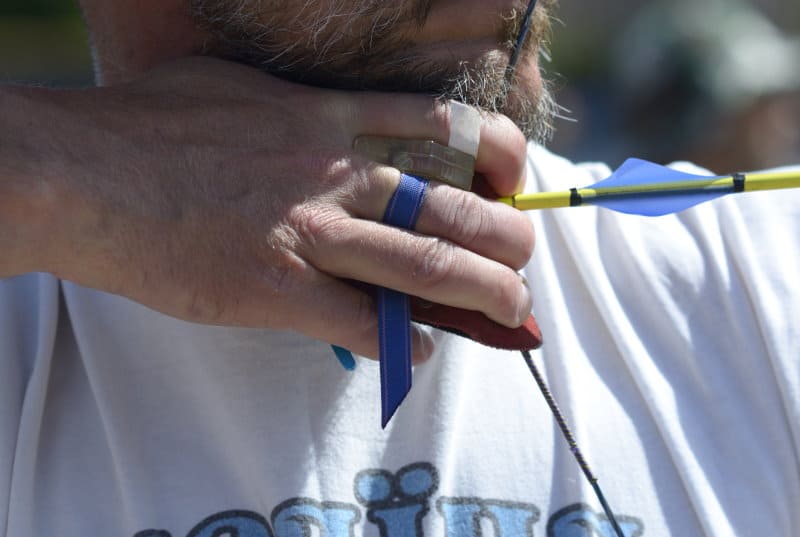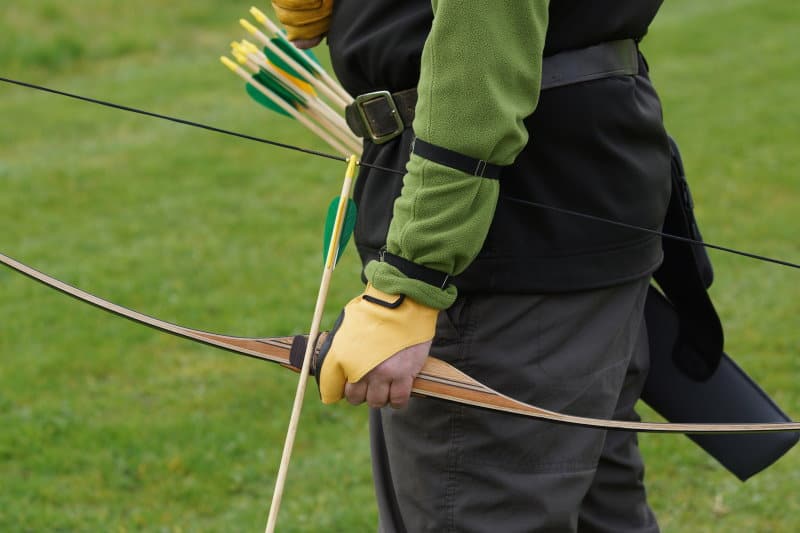Is there anything worse than lining up the perfect shot and having it miss because you didn’t check your bowstring? When it comes to your bow, it’s the bowstring that will go first. To keep this from happening at the worst of times, you need to know how to tell if your bowstring has gone or is about to go bad.
This article will focus on compound bows, but only because compound bows have more string issues than more traditional bows. This means that, if you’re using a longbow or a recurve bow, then you’ll also be able to find answers about your bowstring in this article because there are six key signs we look for:
Sign 1: Spotting a broken string or cable is a clear sign that your bowstring has gone bad and the only way to fix it is to replace it.
Sign 2: A frayed bowstring isn’t quite broken yet, but it is very close and will negatively affect your shooting experience, you can apply wax in an attempt to keep it together, but it is often best to just replace it.
Sign 3: As the string is pulled back shot after shot, stretching can occur. This is why you need to know how to recognize if you’ve overstretched your bowstring. Your bowstring will need to be replaced more often for stretching if you use it a lot.
Sign 4: As your bowstring gets older, there is a very real chance that it will stop being as waxy as it should be. A dried out bowstring is a sign that your string is going bad.
Sign 5: A bowstring is typically covered in a layer of thread called the serving. When this starts to separate from the string, you have an issue. This can be kept together with some tender care, but it is often a sign to replace your string soon.
Sign 6: Finally, if your bowstring is getting old, then it may be a good idea to replace it anyway because it’s just inviting problems. The older a string gets, the less structurally stable it is, and it is typically safer to replace before use.
So there you have it, six signs that your bowstring is going to need replacing. But if you really want to learn about each of these, then you will need to stick around to read the rest of the article.
Sign 1: A Broken String
This is the easiest problem to spot because it stands out. If you’re using a longbow or a recurve bow, then it will be literally impossible not to spot this problem. A compound bow will be a little different, however.
A compound bow doesn’t just have the main bowstring the way that a longbow does but rather it has quite a few cables that help in firing. These cables are all just as important as your main bowstring and, if any of them have broken, then you will have a hard time firing correctly.
These days, the material used for the strings and cables on your bow are most likely a highly durable fibre. These break less often than classic bowstrings, which had been made either from plants or the hide of hunted animals. However, these new synthetic fibres can break.
When you’re packing your hunting or target shooting gear, before you even leave the house, make sure you check your bow for any broken strings. If you are still new to archery and don’t know everything, you should check on your compound bow, then simply run your finger along each string and cable to see if it is broken anywhere.
Once you get to where you’ll be shooting, go ahead and check the strings one more time. This is a smart idea to do before you start shooting. Plus, if you run the finger test mentioned above, then this habit will also let you catch the next sign of a bowstring gone bad.
Sign 2: A Frayed String
A frayed string is harder to spot than a broken string because a frayed string is still fully connected. However, some part of the string is being rubbed against a solid object, and such can happen where the string meets the bow, or it is simply experiencing too much tension through usage and is starting to fray.
While a bowstring is made out of lots of fibres, they are worked into a string because each individual fibre isn’t very large. As these tiny strings begin to break apart, you see the larger overall bowstring fraying. If it is left without maintenance for a long time, eventually, a frayed bowstring will break.

If you are checking your gear before you leave the house, then you have the perfect opportunity to spot fraying. Many people notice that their bowstring is starting to fray, yet they keep using it anyway. They seem to think it will be easier to use the string a little longer than it is to simply replace it. They might even add some wax or something to the bowstring to keep it together, but there is no way to fix a frayed bowstring.
The section of your bowstring that is fraying represents the weakest part of your bow. As you continue to use it, you only manage to make it weaker. Eventually, the string has to snap, but you will be unable to predict when. It will happen when it does.
If you’re drawing an arrow when it snaps, which is likely considering how fraying happens, you are at risk of major injury. A string breaking on a compound bow has been known to cut through flesh and even muscle. Always, always check your string for fraying before use.
Sign 3: A Stretched String
Stretching your bowstring is the most important part of archery. If you can’t stretch your bowstring, then you can’t shoot an arrow. So, just how exactly can a stretched string be a bad sign?
What happens when you are shooting an arrow is that you are creating a tension in the bowstring. You are pulling it back when it wants to be at its resting position. When you let go of the bowstring it snaps back to this position. However, drawing back and firing your bow in this manner causes a release of energy within the bowstring, then on to the arrow. The more often you shoot, the more energy we are talking about. This energy appears in how the bowstring will start to stretch a little bit more each time it is fired.
As your bowstring begins to stretch, there isn’t much to worry about. It happens naturally anyway, and a little bit of stretch doesn’t really mess with your accuracy. But, as this continues, there will be a clear effect. More energy from each shot is absorbed by the bowstring, resulting in less energy making it to the arrow, thus also resulting in weak and inaccurate shots.
The stretching of the bowstring is called creep, and it typically happens somewhere between shooting 50 to 100 arrows. The fibers in the bowstring are being stretched out, making the string itself longer. Creep happens most often due to shooting, but poor storage of a bow in an overly hot location will also produce creep.
The only way to fix a stretched bowstring is to change it. You can’t shrink down a stretched string; you can only throw it out. Before you head out into the woods for some archery, try drawing back your bowstring a couple of times to see if it is as taut as it is supposed to be. If it isn’t, then you should replace the string.
This is one of the more common ways for your bowstring to go bad, as it happens naturally based on how much you are using it. Depending on the number of arrows you are shooting in a session, this could be a long time coming, or it could happen in a single afternoon. How often you experience a stretched string is entirely up to how much you shoot. If you shoot a lot, then you’ll want to keep extra bowstrings on hand whenever you go out.
Sign 4: A Dry String
A bowstring should be waxy. You may find that the string’s feeling in y0ur hand and fingers isn’t particularly pleasant; after all, when you first picture using a bow, you probably didn’t imagine the string as being waxy. However, this aspect is actually important for the string. A waxy bowstring is a functional bowstring, whereas a bowstring that has dried out is difficult to work with and reduces accuracy while increasing the risk of breaking.
Your bowstring needs to be waxed periodically. This is done by using a wax stick. These pretty much just look like a tube of lip balm, except you would run it over your bowstring rather than your lips. After you go over the string with the stick, make sure you use your thumb and forefinger to go over the string and work the wax into it fully. You can tell your string needs to be waxed when it feels dry to the touch, or if you see small hairs sticking out.

These hairs sticking out from the bowstring are often described as “furry” as in “I have a furry bowstring.” It is this furry look that is the most disconcerting. The furry aspect of the bowstring comes from where the fibres that make up the string are starting to wear. A fresh waxing will help to keep the hairs in place and looking slick but it isn’t the end all solution. In time, you will find that your bowstring is looking furrier and furrier.
As a bowstring begins to reach the end of its life, it gains more issues staying waxy. You will find yourself needing to apply wax more and more often to prevent it from becoming furry. When this starts to happen ,you know that you’ll need to replace your bowstring very soon. This is because a dry bowstring leads to a furry bowstring, which then leads to a frayed bowstring.
So, not only do you need to check your bowstring to see if it is dry or waxy, but you will also need to pay attention to how often you are waxing it as well. It is a good idea to keep a record of how often you are waxing your bowstring. This can be on a calendar or in a notebook, but it can be just as easy to keep the record in your phone. Seeing how often you need to wax will help you to get a better sense of how long the bowstring will last overall.
Sign 5: A Seperated String
A bowstring is covered by a layer referred to as the serving. This is a thread that covers up the fibres of string. Compound bows also have serving overtop of the various cables that the bow uses. The serving is mostly there to go over the nocking area of the bowstring and help keep the arrow in the same position, firing with the same amount of power.
A compound bow has serving typically over any of the areas where the bowstring or one of the cables comes into contact with any of the pieces of the bow, like the roller guard or string stop. Those who use a compound bow must make checking the serving a part of their regular maintenance and check-up. This begins with the bowstring but then stretches out into the other areas where the serving has been added.
Serving should be a tight coil that wraps around the bowstring. But, because it is still made out of a fiber, it can break just as easily as your bowstring itself. Over time, the serving begins to separate and come apart from the string and cables that it is protecting.
When checking your serving, keep in mind that you should replace any you see that are starting to separate. However, the serving around the nocking area is absolutely the most important, and it must be changed immediately because it will have a direct effect on your shot, your accuracy, and the safety of the bow itself.
Sign 6: An Old String
The final reason is that you simply have a bowstring that is too old. All of the previous signs arise from the use of the bow itself. Each part of the bow degrades over time due to repetitive use. This is a natural part of archery and something that every archer needs to learn to deal with.
However, another issue that could cause your bowstring to degrade is time. You should never, ever have a bowstring on your bow that is more than two years old. The same goes for the cables used by a compound bow. If you are firing your bow regularly, then you’ll never make it this long without replacing them, but if it’s in storage, then it is easy to let a lot of time go by before using it again. Replace the bowstring before you hit this range.
If you’ve never had to change a bowstring before, don’t worry; it really isn’t that hard. This informative video will walk you through how to change your string and your compound cables:
You can purchase new strings for your bow individually or in bulk. I like making use of both from time to time. For example, I like to keep a lot of strings around, but I’ll also splurge from time to time to get a more expensive string like this one. I find it helps give a sense of the real difference between bowstrings. Spoiler: often there is very little.
Old strings should not be trusted. As much as you may just want the ability to pull your bow out of storage and give it a couple shots, it is always best to replace the string prior to shooting. There is not a set timeframe that works to set when a string should or shouldn’t be replaced, but I won’t shoot a string that hasn’t been tested in over a year. It is just safer to replace it with a new one and check all the pieces in the process.
Outro
So there you have it—six ways you can tell that your bowstring is going bad, ranging from the obvious to the more stealthy. The important thing to understand about this topic is that none of what you read matters in the least if you don’t put it into practice.
This means that you absolutely must make checking your bowstring a regular part of using your bow. You should never, under any circumstances, start shooting your bow before you have inspected it. Your bow may be a simpler weapon compared to a hunting rifle, but it requires just as much care and respect to keep it firing correctly.
So, next time you’re ready to hit the range or woods to start taking some shots, make sure you stop and inspect your string first. It’ll make your life a thousand times easier in the long run.

